7 Common Houseplant Pests and How to Get Rid of Them Safely (original) (raw)
If your houseplants gave you a bit more than you bargained for, don't toss them! Instead, eradicate houseplant pests with our easy and affordable tips.
Now Trending
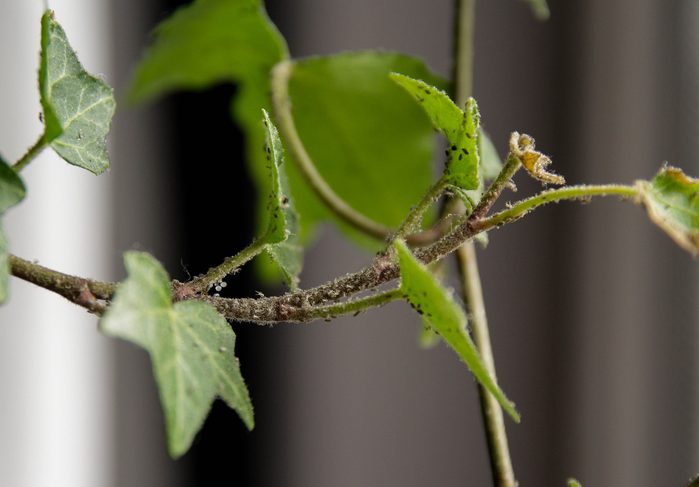
Kinga Krzeminska/Getty Images
Say goodbye to houseplant pests!
Nothing spruces up your space quite like indoor plants. Whether you’re a newbie looking for the best low-maintenance indoor plants for your living room or a seasoned gardener interested in growing medicinal plants, you’ve got plenty of options to choose from. There are even low-light indoor plants that thrive in near darkness and air-purifying plants that could help you breathe easier. The only problem? Your houseplants sometimes come with unwanted hitchhikers—houseplant pests that eat away at your foliage and decimate your decor. And here you thought your biggest issues would be how to arrange your plants and whether you remember to water them!
Put simply, infestations can happen, so don’t let the thought of them deter you from buying plants online or at your local nursery. The good news is that although they’re a nuisance, most houseplant pests aren’t dangerous to humans or pets. They’re also generally easy and cheap to get rid of, especially if you know the tips we’re about to share. Read on to learn more about the seven most common houseplant pests and how you can get rid of them for good.
Get _Reader’s Digest_’s Read Up newsletter for more plant tips, humor, cleaning, travel, tech and fun facts all week long.
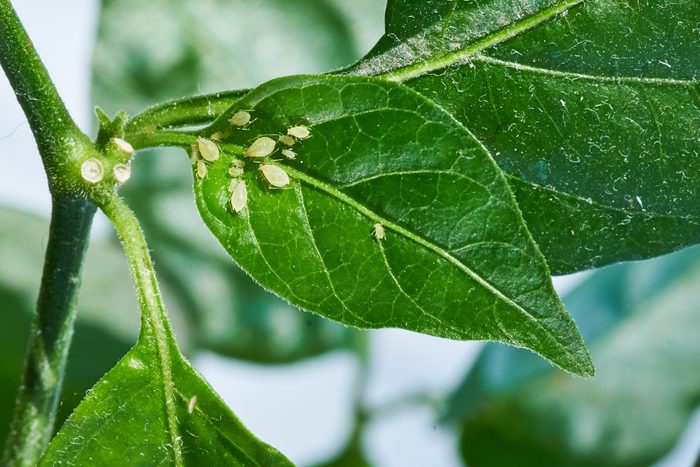
Aleksandr Rybalko/Getty Images
Aphids
Aphids, also known as plant lice, are tiny pear-shaped bugs that suck the sap from plants. You’ll often spot them feeding on new growth or plant stems, which can cause misshapen, curly or yellowing leaves and overall stunted growth. Additionally, aphids leave behind a sticky waste product called honeydew, which encourages the growth of sooty mold and fungus.
The best way to get rid of aphids
Luckily, there are a few simple ways to get rid of aphids. Once you’ve identified them, use your garden hose to spray them off your plant, or wipe them away with a paper towel dipped in rubbing alcohol. To be sure they don’t come back, spray your plant two to three times a week with a mixture of water and a few drops of gentle dish soap. Do this for a couple of weeks, or until you are sure there are no more aphids. If you’re dealing with a heavy infestation, use an insecticidal soap or neem oil. These products will kill aphids on contact without causing further damage to your plant.
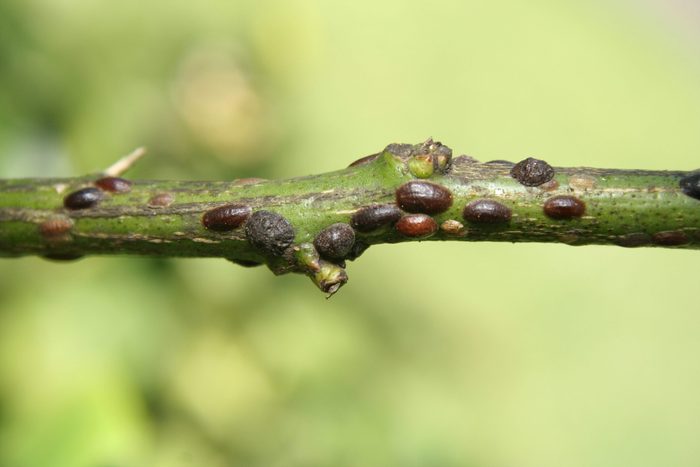
Andrew Waugh/Getty Images
Brown scale
Scale insects may be harder to identify at first, since they look more like a non-moving, waxy growth than an insect. They suck the sap out of plants and are typically found on the stems or undersides of leaves. Though you may not notice much damage from a few scales, an infestation will weaken your houseplants, leaving them vulnerable to diseases and other pest infestations.
The best way to get rid of scale
Fortunately, it’s relatively simple to get rid of scale on plants. These houseplant pests can easily be removed with a paper towel dipped in rubbing alcohol or a toothbrush and some warm soapy water. It’s worth noting that like aphids, scales can leave behind sticky honeydew. A toothbrush and warm soapy water will take care of that problem along with the bugs themselves. And, if you’re not squeamish, you can even scrape off scale bugs with your fingernail. For heavy infestations, opt for insecticidal soap or neem oil, which will kill scale youngsters. FYI, these treatments are safe for your pets, but beware of certain plants: The following plants are poisonous to dogs and cats.
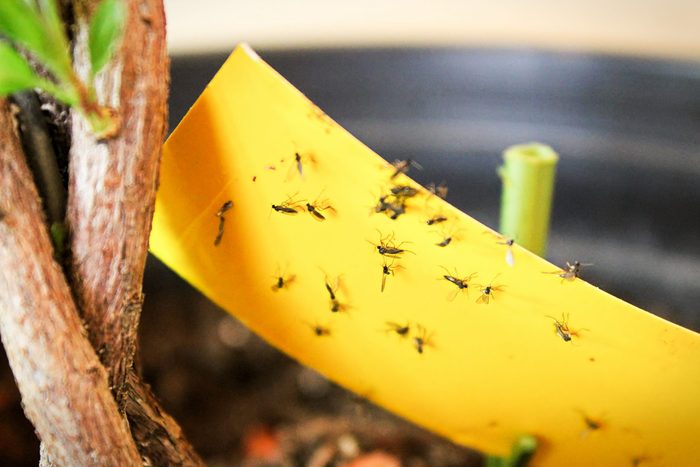
Akchamczuk/Getty Images
Fungus gnats
When it comes to these flying pests, their name alone is enough to make you gag. But if you’re a newer plant parent who doesn’t know much about plant watering, you run the risk of attracting these pests that like to lay their eggs in the moist soil of overwatered plants. Once the eggs hatch, they burrow farther down into the soil and feed on your plant’s roots and other organic plant material. The good news is that these gnats don’t bite or spread diseases to humans. The bad news is that they will wreak havoc on your plants. When left untreated, fungus gnats can cause yellowing leaves, slowed growth, withering and root rot.
The best way to get rid of fungus gnats
There are a few ways to get rid of fungus gnats, ranging from simple DIY methods to insecticides. For starters, you’ll want to let your soil dry out. If you’ve been overwatering your houseplants, you may even want to consider learning how to repot your plants to give them a fresh start. You can also set a homemade trap using apple cider vinegar, dish soap and water. The smell of the vinegar will attract the gnats, which will drown once they hit the soapy water. Another method involves placing slices of raw potato in the soil. This will attract larvae, which you can then dispose of—all in one fell swoop.
The easiest way to get rid of fungus gnats, however, is to purchase a pack of ready-to-use sticky traps and place them in the soil around your plant. The gnats will fly right to them and get stuck. Once the trap is full, simply throw it away and replace it with a new one.
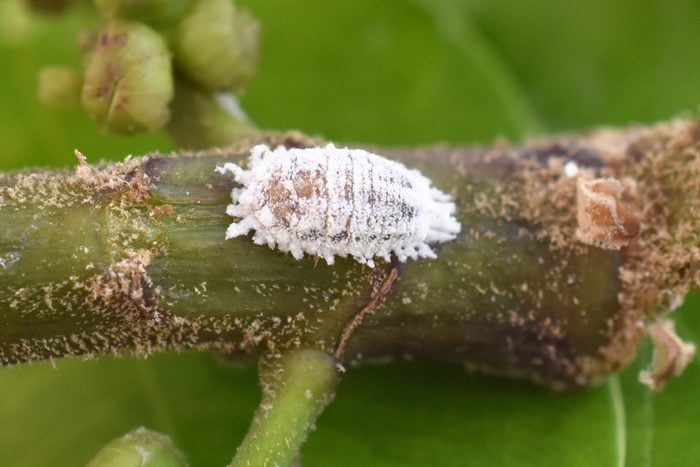
HHelene/Getty Images
Mealybugs
If you’ve noticed white spots on your plants, you could be dealing with either powdery mildew or mealybugs. Mealybugs are small, white, oval-shaped bugs. Like their cousins, brown scale insects, these houseplant pests have a waxy coating and can be hard to spot at first. But once they mature, odds are they’ve already been busy laying hundreds of eggs and sucking the sap from the leaves and stems of your favorite houseplant. Mealybugs can cause yellowing leaves and the premature loss of fruits, vegetables and flowers. And like so many other plant pests, they leave their honeydew behind, which encourages the growth of sooty mold and blocks much-needed sunlight from reaching your plant.
The best way to get rid of mealybugs
If you spot them early, it’s fairly easy to get rid of mealybugs—you can simply wash them away under a stream of water. If you want a more permanent solution, dab them directly with a cloth or cotton ball dipped in rubbing alcohol; this will kill them. Insecticidal soap or neem oil will also get rid of mealybugs. Whichever method you choose, just be sure to check your plant every few days and repeat the treatment as needed to be sure that the bugs are gone.
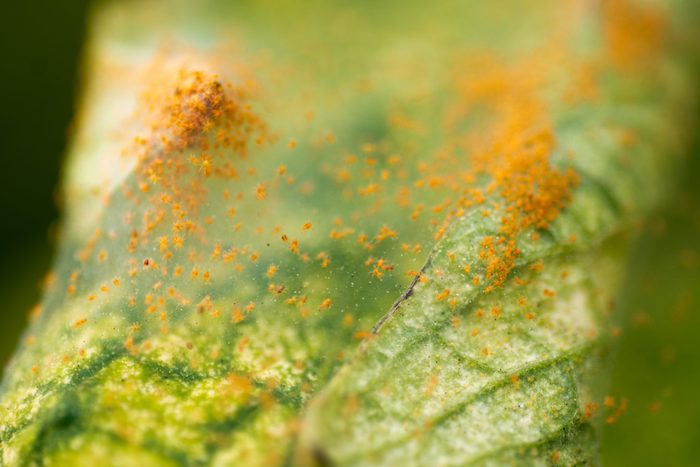
jopstock/Getty Images
Spider mites
If the thought of spiders crawling around your home gives you the chills, you’ll definitely want to know how to get rid of spider mites. Like spiders, these microscopic pests are arachnids. They have eight legs and produce a fine, silky webbing. The mites can be hard to see because of their size, so you may not know there’s an infestation until your plant shows signs of distress. You may notice that your plant’s leaves have changed color or are falling off prematurely. If the infestation is large enough, you may even spot some webbing. Spider mites tend to colonize in large numbers on the underside of leaves, where they suck out the sap. You’ll need a magnifying glass to really get a good look at these pests, but if you suspect spider mites, turn the leaves over and look for tiny moving dots.
The best way to get rid of spider mites
Getting rid of spider mites is easier than it sounds, since these pests are easily washed away with water. Simply spray the leaves with your garden hose, faucet or shower head to knock them off your plant. Once you’ve washed them away, you can treat your plant with an insecticidal soap or neem oil to kill any stragglers. And while we’re on the topic, here’s how to get rid of spiders in your home.
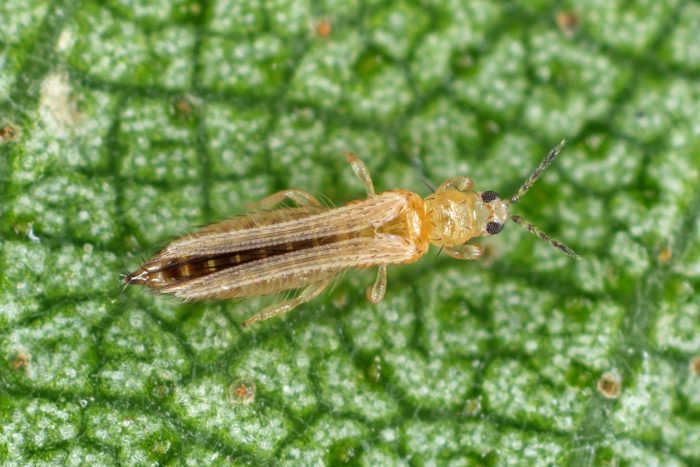
Tomasz Klejdysz/Getty Images
Thrips
Thrips are tiny winged insects that look like dark slivers on your plant’s leaves. Though they’re not strong fliers, they do move quickly if you get too close. Telltale signs of a thrip infestation are streaks, silvery speckling and small white patches, which are the result of the thrips literally sucking the life out of your plant. Thrips are also especially dangerous pests because they can transmit viruses to your plants.
The best way to get rid of thrips
Unfortunately, getting rid of thrips isn’t as easy as getting rid of other houseplant pests. Start by spraying your plant with a solution of dish soap and water (1 to 2 tsps. per gallon of water), and be sure to really spray the bottoms of the leaves, which is where thrips like to congregate. Next, prune any damaged leaves. And finally, treat your plant with neem oil or a botanical insecticide containing pyrethrin. If your plant is in really bad shape, follow these steps to revive a dead or dying plant.
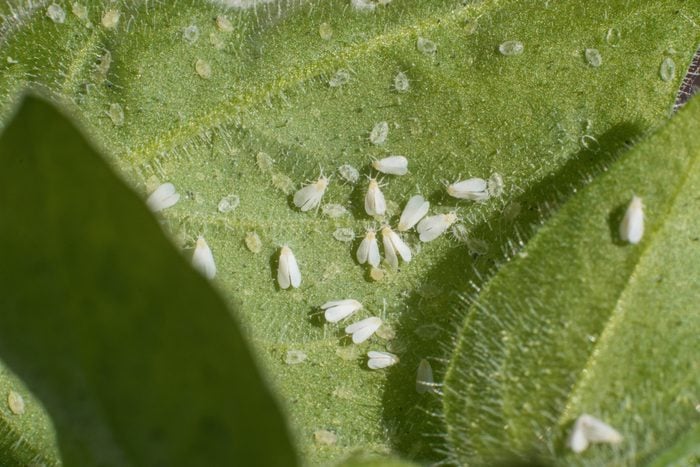
Tunatura/Getty Images
Whiteflies
Whiteflies are small, flying insects that hide out on the underside of plant leaves and feed on the sap. They’re especially attracted to flowering plants, vegetables and indoor plants with soft, smooth leaves. Whiteflies weaken plants and cause leaves to wilt or turn yellow. They also leave behind honeydew, which encourages the growth of sooty mold. The easiest way to determine whether you have whiteflies is to move your plant. Once it’s disturbed, you can’t miss the swarm of tiny flies that erupts into the air surrounding it. Talk about gross!
The best way to get rid of whiteflies
Since no one wants a swarm of whiteflies buzzing around their beloved apartment plants, getting rid of whiteflies should be at the top of your plant-care priority list. You’ll want to get rid of existing flies first. Do this by blasting them with a stream of water from your garden hose or faucet. You can also add a squirt of dish soap to a gallon of water and spray that on your plant. Another cheap and easy way to get rid of whiteflies is to place yellow sticky traps in the soil around your plant to reduce their numbers. Last, you can treat your plants with insecticidal soap or neem oil to rid them of existing eggs or larvae.
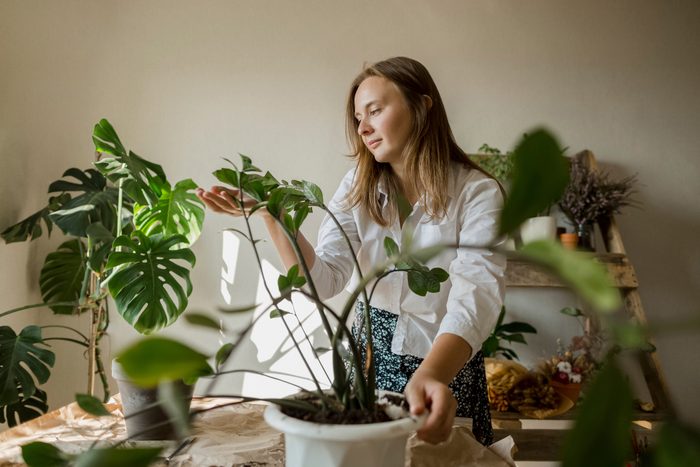
Westend61/Getty Images
How to prevent a pest infestation
No one wants to deal with houseplant pests, but they’re bound to pop up sooner or later. If you want to prevent a full-blown infestation, your best bet is to take preventive measures.
Educate yourself
Download the best plant-care apps to learn exactly how to care for your specific plant. After all, the best way to care for your spider plant may be radically different from the best way to care for your snake plant or prayer plant.
Inspect plants on a regular basis
Whether you’re bringing an outdoor plant inside for the winter or taking home a new plant from your local nursery, give it a thorough inspection before it crosses your threshold. And don’t stop there. Pests can hitch a ride inside on your clothes or via your pets. Also give your plants a once-over every few days or every time you water them to ensure they remain pest-free.
Quarantine infested plants
Have more than one houseplant? Once pests are in your home, they can quickly move from plant to plant. That’s why it’s important to quarantine infested plants while you treat them. And yes, moving tall indoor plants around can be tricky, but you’ll be glad you did. Once you’re sure you’ve remedied the problem, you can put the plant back in its original space.
Now that you know how to combat houseplant pests, consider creating a stunning living wall in your home. It’s easier than you think!